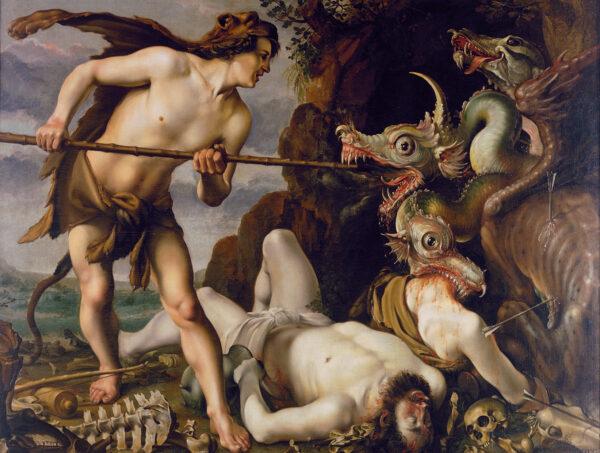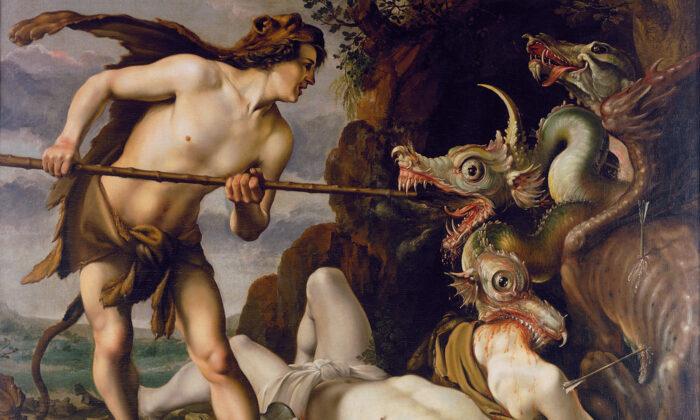In Greek mythology, Cadmus is considered the first Greek hero. He followed the guidance of the gods and would later become the founder and first king of Thebes.
Cadmus was a prince born to King Agenor and Queen Telephassa. When Cadmus was a young man, his sister Europa was kidnapped by Zeus, who had disguised himself as a white bull. Zeus took Europa to Crete, where she became the island’s first queen and would later give birth to the cruel King Minos.
Europa’s family, however, had no idea what had happened to her. King Agenor sent his sons out to find her and told them not to return unless they had.
The sons were all unsuccessful and settled throughout the land, as they were unable to return home. Cadmus, though, was unwilling to give up just yet, and went to the Oracle of Delphi to request the gods’ help in finding his sister.
The Oracle, however, told him to stop searching for his sister. Instead, he was to establish a new city by first finding a cow with a half-moon symbol on its flank and then following the animal until it came to rest. At this spot, he was to found the new city.
Cadmus did as he was instructed. He found the cow, and when the cow rested, he decided to sacrifice it to the goddess Athena to thank her for her guidance. He sent his accompanying friends to find pure water for the sacrifice. His friends did find a spring, but they were all attacked and killed by a dragon. When Cadmus found their lifeless bodies, he also found the dragon. To avenge his friends and to retrieve the pure water needed for the sacrifice, the hero fought and defeated it.
When Cadmus finally returned to sacrifice the cow, Athena appeared to him and told him to take the dragon’s teeth and plant them in the earth. Cadmus followed her command.
From the sown teeth, a tribe of warriors grew, who immediately began fighting one another. They fought until only five remained; these made peace and became known as the Spartoi. They helped Cadmus build what would later be the city of Thebes.

“Cadmus Slays the Dragon,” between 1573 and 1617, by Hendrick Goltzius. Oil on canvas, 74.4 inches by 97.6 inches. National Gallery of Denmark. Public Domain
‘Cadmus Slays the Dragon’
In “Cadmus Slays the Dragon,” the 16th-century Dutch artist Hendrick Goltzius graphically depicted the scene in which Cadmus finds and kills the dragon.Cadmus is shown dressed in an animal pelt. He most likely hunted and killed the animal himself, and his pelt now represents his fearlessness in coming face-to-face with and overcoming the dangers of his environment in order to survive.
Fearlessly, Cadmus holds a spear and leans forward to thrust it into the mouth of the center head of the three-headed dragon, which stands in front of its dark cave.
The dragon’s body is pierced with arrows, which suggests the failed attempts of Cadmus’s friends to defend themselves. The dragon’s upper head looks up and outside of the picture plane. Its bottom head swallows the head of one of Cadmus’s friends.
On the ground lies one of Cadmus’s lifeless friends. The bones of animals and humans, the dragon’s previous victims, are scattered on the ground.
A Fearless Approach to Present Danger
Considering the image and the story it shows, what wisdom might we gather from Cadmus’s life and this painting?Goltzius depicted Cadmus as fearless. Cadmus thrusts his spear into the very danger that has destroyed his friends. The dragon represents a danger not only to Cadmus and his men but also to the many adventurers before them, as suggested by the bones strewn on the ground. Cadmus, however, does not run from danger but leans into it.
There are many dangers in our lives today. Drugs, alcohol, promiscuous sex, and money worship are promoted in our arts and media. These are, in part, our dragon.
I’m sure we’ve all witnessed people around us lose years of their precious time on earth in dealing with these dangers. Many of us deal with these dangers ourselves.
We have created a culture that encourages us to journey toward the dragon, not to slay it but to be slain by it. Many of us—both knowingly and unknowingly—sacrifice ourselves to it.
The more we fall victim to these dangers, the more fear consumes us, and the less likely we are to follow the divine path that is available to us.
How would Cadmus deal with these present-day dangers?
On finding his friends’ corpses and seeing the dragon, he could have turned to run away, but he didn’t. He fought the danger that destroyed so many lives.
What makes Cadmus successful when his friends and the adventurers before him were not?
It’s difficult to know why Cadmus was the only one able to defeat the dragon. It’s undeniable, however, that two things contributed to his success: his fearlessness and his willingness to accept the guidance of the gods.
So, I believe that with a fearless attitude and the divine on his side, Cadmus would be able to lean into present-day dangers just as he does in the painting. He would do so not to be victimized by them but to eliminate their threat.
Cadmus would be fearless in his approach, but this doesn’t mean he would be reckless. He could have thrown the spear from a distance, but instead he had the courage to get close to the dragon and thrust his spear into the very spot that would get the job done. He understood his enemy and what was needed to accomplish his task.
Only upon defeating the dragon is Cadmus directed by Athena to plant its teeth, bring forth the warrior tribe, and build his new city. Maybe we’re meant to defeat that which threatens us and build something new from its remains.
How might we first identify the dangers that lurk in our lives? How might we assess our own path to make sure that we truly have the divine on our side? How might we muster the courage, the fearlessness, to lean into our dangers in order to understand them and destroy them once and for all so that we can continue building not only cities and cultures, but lives worthy of the divine?
The traditional arts often contain spiritual representations and symbols the meanings of which can be lost to our modern minds. In our series “Reaching Within: What Traditional Art Offers the Heart,” we interpret visual arts in ways that may be morally insightful for us today. We do not assume to provide absolute answers to questions generations have wrestled with, but hope that our questions will inspire a reflective journey toward our becoming more authentic, compassionate, and courageous human beings.
Eric Bess is a practicing representational artist and is a doctoral candidate at the Institute for Doctoral Studies in the Visual Arts (IDSVA).





